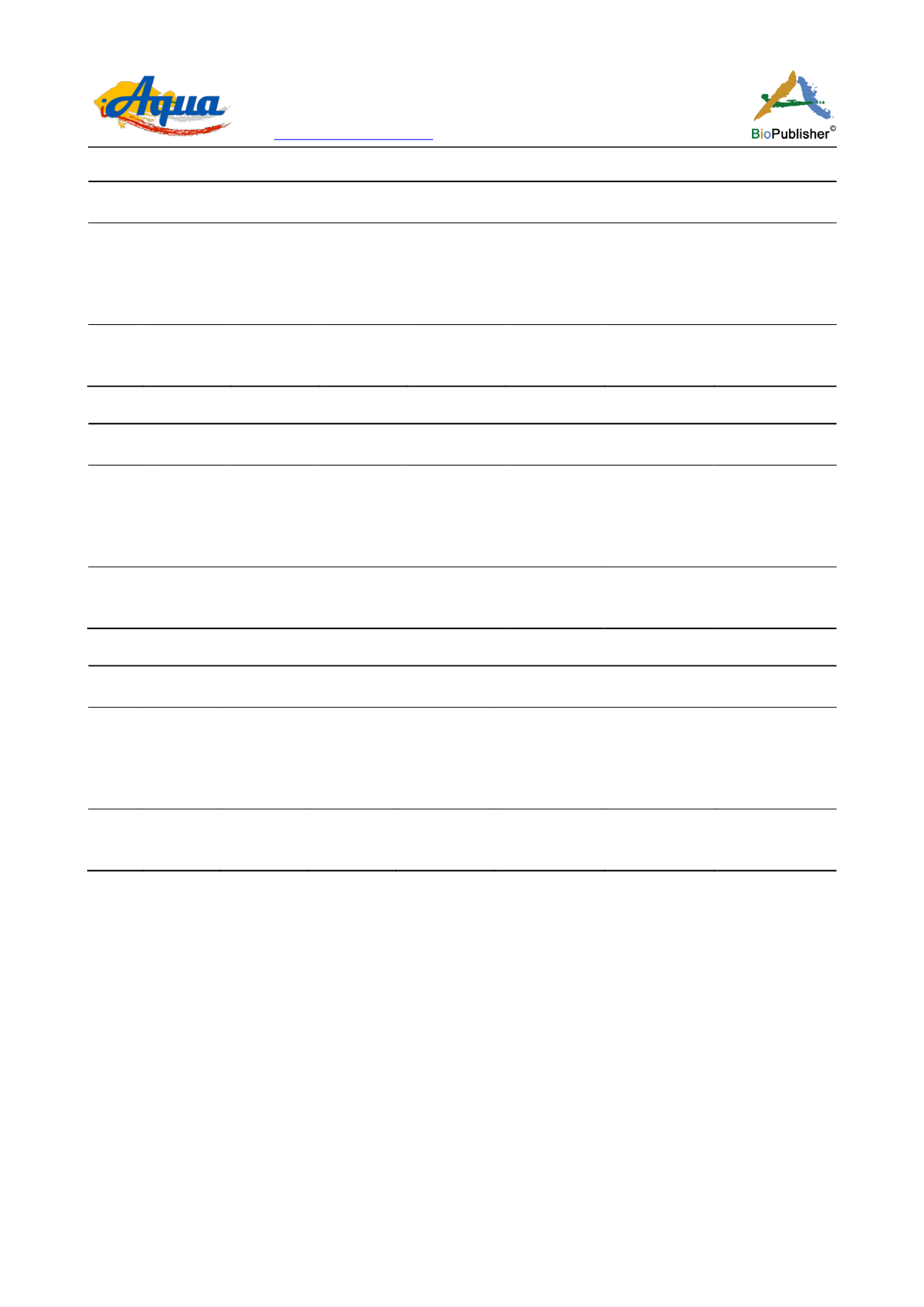
International Journal of Aquaculture, 2017, Vol.7, No. 2, 9
-
14
11
Table 2 Mean concentrations selected of some water quality parameters in earthen pond systems
DRY SEASON 1
Farms
pH
Temp.
°
C
DO (mg/L) TDS (mg/L)
Nitrite (mg/L) Nitrate (mg/L)
Ammonia (mg/L)
OOF
7.3 ±0.01
31.0 ±0.10
4.0 ±0.02
304
0.06 ±0.01
9.40 ±0.02
0.3 ±0.01
SFL
7.4 ±0.02
29.0 ±0.12
5.04 ±0.01
379
0.20 ±0.01
3.70 ±0.04
0.4 ±0.02
KFF
7.5 ±0.02
30.0 ±0.10
5.08 ±0.02
364
0.02 ±0.02
4.60 ±0.02
0.2 ±0.01
DRY SEASON 2
Farms
pH
Temp.
°
C
DO (mg/L)
TDS (mg/L)
Nitrite(mg/L) Nitrate (mg/L)
Ammonia (mg/L)
OOF
7.3 ±0.01
30.0 ±0.10
9.1 ±0.02
380
0.03 ±0.01
4.2 ±0.01
0.4 ±0.01
SFL
6.9 ±0.08
28.2 ±0.12
6.8 ±0.02
378
0.02 ±0.01
9.4 ±0.01
0.3 ±0.03
KFF
7.0 ±0.02
31.0 ±0.10
12.0 ±0.01
365
0.02 ±0.01
4.6 ±0.02
0.2 ±0.01
Table 3 Mean concentrations of some water quality parameters in Concrete tank systems
WET SEASON 1
Farms
pH
Temp.
°
C
DO (mg/L)
TDS (mg/L)
Nitrite(mg/L) Nitrate (mg/L)
Ammonia (mg/L)
VFF
7.3 ±0.05 27.6 ±0.12
7.1 ±0.30
200
0.04 ±0.01
4.0 ±0.09
0.8 ±0.04
EKF
6.8 ±0.04 28.0 ±0.10
5.08 ±0.01
250
0.05 ±0.02
6.4 ±0.05
0.5 ±0.08
ASF
8.5 ±0.02 27.5 ±0.12
7.0 ±0.02
278
0.07 ±0.01
6.5 ±0.05
0.9 ±0.02
WET SEASON 2
Farms
pH
Temp.
°
C
DO (mg/L)
TDS (mg/L)
Nitrite(mg/L) Nitrate (mg/L)
Ammonia (mg/L)
VFF
7.1 ±0.08 27.8 ±0.12
7.1 ±0.02
340
0.08 ±0.01
1.8 ±0.02
0.6 ±0.01
EKF
7.5 ±0.04 28.2 ±0.10
6.2 ±0.01
325
0.07 ±0.02
4.6 ±0.01
0.3 ±0.02
ASF
8.0 ±0.05 28.0 ±0.10
6.0 ±0.01
360
0.15 ±0.01
6.5 ±0.02
0.4 ±0.01
Table 4 Mean concentrations of some water quality parameters in Concrete tank systems
DRY SEASON 1
Farms
pH
Temp.
°
C
DO (mg/L)
TDS (mg/L)
Nitrite (mg/L)
Nitrate (mg/L)
Ammonia (mg/L)
VFF
6.9 ±0.04 27.5 ±0.12
5.8 ±0.09
299
0.10 ±0.04
6.6 ±0.02
0.5 ±0.04
EKF
6.9 ±0.09 30.0 ±0.10
5.08 ±0.06
320
0.06 ±0.01
7.2 ±0.01
0.5 ±0.08
ASF
6.8 ±0.06 27.8 ±0.20
8.50 ±0.05
333
0.15 ±0.01
8.0 ±0.02
0.7 ±0.02
DRY SEASON 2
Farms
pH
Temp.
°
C
DO (mg/L)
TDS (mg/L)
Nitrite (mg/L)
Nitrate (mg/L)
Ammonia (mg/L)
VFF
7.2 ±0.07 27.8 ±0.13
5.08 ±0.01
306
0.20 ±0.01
6.6 ±0.01
0.9 ±0.09
EKF
7.6 ±0.01 29.0 ±0.10
4.06 ±0.02
325
0.19 ±0.01
8.6 ±0.02
0.9 ±0.01
ASF
7.8 ±0.01 30.0 ±0.12
6.20 ±0.01
402
0.06 ±0.01
8.9 ±0.01
0.5 ±0.02
Temperature:
Temperature
is defined as the degree of hotness or coldness in the body of a living organism either
in water or on land. It is the most important physical variable affecting the metabolic rate of fish and is therefore
one of the most important water quality attributes in aquaculture (IEPA, 2001). Each species has an optimum
temperature range of where it grows best. At temperatures above or below optimum, fish growth is reduced.
Mortalities may occur at extreme temperatures above or below optimum temperatures (Joseph et al., 1993). The
mean value obtained in this study was between 29.1 ±0.04
°
C and 28.2 ±0.06
°
C for EPs and CTs, respectively.
Delince (1992) stated that, temperature between 30-35
°
C is tolerable to fish. Bhatnagar et al.
(2004) suggested the
levels of temperature 28-32
°
C as good for tropical major carps; < 12
°
C as lethal but good for cold water species; <
20
°
C is sub lethal for growth and survival of fishes and > 35
°
C as lethal to maximum number of fish species.
Temperature was significantly different among the culture systems (Table 5).
Dissolved Oxygen (DO):
DO is an important environmental parameter for the survival of aquatic life. D.O.
values measured in the culture systems ranged between 4.0 mg/L and 15.4 mg/L with a mean of 7.5 ±0.05 mg/L
and 4.06 mg/L and 8.5 mg/L with a mean of 6.1 ± 0.01 mg/L for EPs and CTs, respectively. There was no
significant difference (p > 0.05) between culture systems and also between seasons (p > 0.05). Dissolved oxygen
affects the growth, survival, distribution, behaviour and physiology of aquatic organisms. The amount of oxygen


